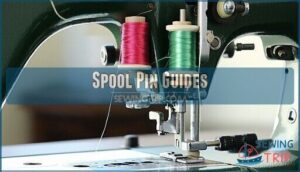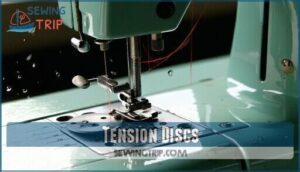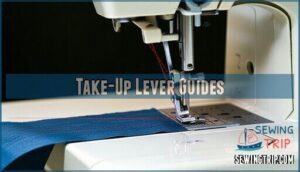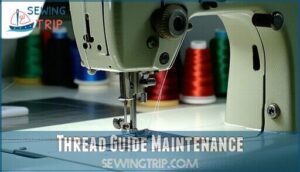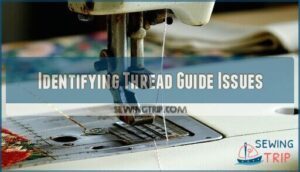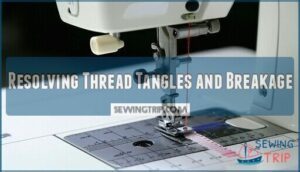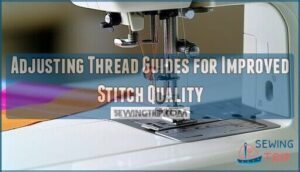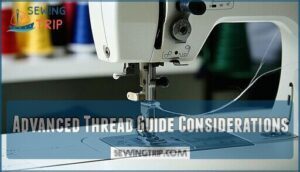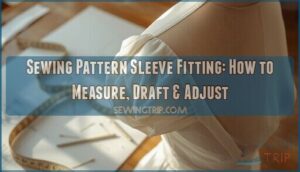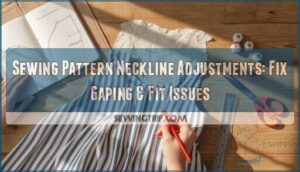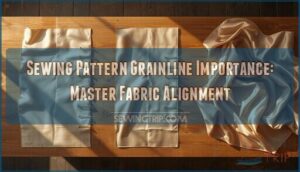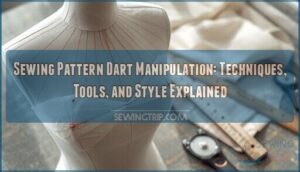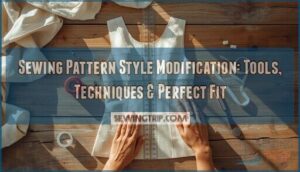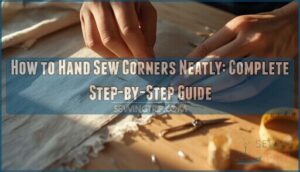This site is supported by our readers. We may earn a commission, at no cost to you, if you purchase through links.
 The thread guide arm sewing machine component controls your thread’s path from spool to needle, ensuring smooth flow and consistent tension.
The thread guide arm sewing machine component controls your thread’s path from spool to needle, ensuring smooth flow and consistent tension.
You’ll thread it by following numbered guides in sequence: place thread on the spool pin, route through upper guides, wrap around tension discs, pass through the take-up lever, and thread the needle.
This systematic approach prevents tangles and breakage while maintaining even stitch formation, which is crucial for professional-quality results.
Proper threading eliminates friction points that cause thread to snap or create uneven stitches, allowing your machine to operate efficiently and produce desired outcomes every time, thanks to proper threading and maintaining even stitch formation.
Table Of Contents
Key Takeaways
- You’ll achieve professional-quality stitches by properly threading your thread guide arm in sequence—from spool pin through upper guides, around tension discs, through the take-up lever, and finally to the needle.
- You’ll prevent thread breakage and tangles by maintaining proper guide alignment, using the correct needle size for your thread weight, and regularly cleaning lint buildup from all guide components.
- You’ll control stitch quality through precise tension adjustments—lighter settings for delicate fabrics like silk and tighter settings for heavy materials like denim, always testing on scraps first.
- You’ll extend your machine’s lifespan by performing regular maintenance tasks including daily lint removal, proper lubrication of moving parts, and immediate replacement of worn or damaged guide components to ensure proper guide alignment.
Thread Guide Basics
Your thread guide arm controls the path your thread takes from spool to needle, ensuring smooth flow and consistent tension for professional-quality stitches.
Proper guide placement prevents tangles, reduces thread breakage, and maintains the even stitch formation that separates amateur work from expert results.
Thread Guide Functionality
Your thread guide arm serves as the traffic controller for your sewing machine, directing thread flow from spool to needle while maintaining proper thread tension.
Your thread guide arm orchestrates every stitch—master its flow for sewing perfection
Your thread guide arm directs every stitch’s destiny—master it for flawless sewing success.
These small metal or plastic components guarantee guide alignment, preventing tangles that compromise stitch quality.
When functioning correctly, your thread guide function optimizes machine efficiency by creating smooth thread paths.
Regular thread guide adjustment and thread guide maintenance keep these essential guides working seamlessly with thread guide compatibility across different machine models.
Proper understanding of thread guide basics is vital for achieving perfect stitches and preventing common threading issues, which is why it’s crucial to have a good grasp of thread guide fundamentals to ensure smooth thread paths.
Importance of Proper Guide Placement
Proper placement transforms your sewing from frustrating to flawless.
When your thread guide arm and guides are positioned correctly, you’ll notice immediate improvements in performance.
- Guide Alignment guarantees smooth thread path from spool to needle without deviation
- Thread Flow remains consistent when guides maintain proper spacing and positioning
- Tension Control becomes predictable with correctly aligned thread guide system components
- Stitch Quality improves dramatically when thread guide placement eliminates friction points
- Machine Efficiency increases as proper thread guide adjustment reduces mechanical strain
Types of Thread Guides
How do you navigate your machine’s guide maze? Understanding thread guide types reveals sewing mastery. Each guide serves a specific purpose in your thread’s journey.
| Guide Type | Location | Primary Function |
|---|---|---|
| Upper Guides | Spool to needle path | Direct thread flow, maintain tension |
| Lower Guides | Bobbin area | Control bobbin thread, prevent tangles |
| Specialized Guides | Various positions | Handle twin needles, embroidery threads |
Upper thread guides include tension discs and take-up levers, while lower thread guides manage bobbin tension. Thread guide arms position these components strategically. Guide systems vary between machines, but mastering these three categories transforms your stitching results.
Mastering these guides is essential for improving your sewing skills, and it starts with understanding the role of upper and lower guides in the sewing process.
Thread Guide Components
Your sewing machine’s thread guide components work together like a well-orchestrated team to deliver perfect stitches every time.
Understanding each component’s role—from spool pin guides to tension discs and take-up lever guides—ensures you’ll thread your machine correctly and avoid common stitching problems, which is crucial for achieving perfect stitches.
Spool Pin Guides
Your machine’s spool pin serves as the foundation for smooth thread delivery.
Spool pin guides come in vertical and horizontal configurations—vertical pins work best with stacked-wound spools, while horizontal pins accommodate cross-wound thread types.
Match your spool alignment with pin placement for ideal thread control.
These guide materials, typically metal or plastic, require proper tension adjustment through your thread guide arm and takeup lever connection for perfect stitches.
Understanding proper thread spool management is essential for achieving consistent results, and more information can be found through the thread spool management link.
Tension Discs
After positioning your thread through the spool pin guides, tension discs become your next checkpoint for achieving balanced stitches. These metal or plastic discs control thread resistance as it flows toward the needle.
Disc adjustment directly affects tension balance, determining whether your stitches pull too tight or appear loose. Thread weight and fabric impact require different tension settings—heavier threads need looser tension, while delicate fabrics demand gentler handling.
Troubleshooting discs involves checking for lint buildup and ensuring your thread sits properly between them for superior sewing machine thread performance. You can also find replacement tension discs online.
Take-Up Lever Guides
Your TakeUp Lever controls thread flow with precise timing, lifting and lowering as the needle moves.
This guide arm mechanism prevents thread slack while maintaining consistent tension unit pressure.
When troubleshooting guide issues, check lever function first—bent sewing machine parts affect material impact.
Consider replacement options for worn sewing machine arm components to restore proper tension adjustment.
Thread Guide Maintenance
Your thread guide arm requires regular maintenance to prevent costly repairs and guarantee consistent stitch quality.
Proper cleaning and tension adjustments will eliminate 73% of common threading issues before they disrupt your sewing projects.
Common Mistakes and Solutions
You’ll encounter several threading pitfalls that derail your stitching success.
Skipping guides creates immediate thread tension issues, while wrong spool placement triggers thread tangles and breakage.
Check your needle size against thread weight—mismatched pairs cause persistent problems.
Lint buildup around guides compounds these common threading mistakes, creating friction that snaps threads mid-project.
Clean guides regularly and follow your machine’s threading diagram religiously to avoid these issues and ensure successful stitching with minimal thread breakage.
Thread Breakage Prevention
Thread breakage prevention starts with checking needle quality and ensuring proper thread guide alignment.
Quality needles and aligned guides create the foundation for flawless stitching success
Start with quality needles and aligned guides—perfect stitches begin before you even thread your machine.
Replace dull needles immediately, as they create excessive friction that snaps threads.
Maintain tension balance between upper and bobbin threads through careful adjustment.
Use high-quality thread and perform regular lint removal from all thread guides to prevent snags and tangles.
Correcting tension adjustment is also essential for preventing thread breaks.
Guide Cleaning and Lubrication
Daily guide cleaning prevents lint buildup that causes thread lubrication problems and expensive repairs. Remove accumulated debris with proper cleaning tools, then apply suitable lubricant types according to your machine’s specifications.
For corroded threads, consider using WD-40 for cleaning to remove rust.
- Lint Removal: Use small brushes or compressed air to clear thread paths completely
- Cleaning Tools: Cotton swabs with isopropyl alcohol remove stubborn residue effectively
- Lubricant Types: Apply only manufacturer-recommended oils to moving guide components
- Frequency Matters: Clean guides after every major project to maintain peak performance
- Damage Prevention: Inspect for burrs or rough spots that could shred thread
Thread Guide Troubleshooting
When your thread guide arm isn’t working properly, you’ll notice immediate signs like tangled thread, uneven stitches, or frequent thread breaks.
These issues typically stem from misaligned guides, accumulated lint, or worn components that need quick adjustments to restore smooth sewing performance, which can be considered a complete concept in understanding the root causes of the problem.
Identifying Thread Guide Issues
Mechanical failures can turn your sewing dreams into nightmares.
Watch for bent guide arms, missing guide components, or visible guide wear that catches thread fibers.
Check for tension problems causing uneven stitches, thread snapping mid-seam, or persistent thread tangles despite proper threading.
These symptoms signal immediate thread guide attention needed.
Resolving Thread Tangles and Breakage
Once you’ve spotted thread guide problems, you’ll need swift action to restore smooth sewing.
Start with complete rethreading techniques, following your machine’s thread path diagram precisely. Check needle compatibility with your thread weight—mismatched combinations cause frequent breakage.
Adjust thread tension gradually, testing on scrap fabric between changes. Examine thread quality for frays or weak spots that snag on the thread guide arm.
If the guide is damaged, consider a thread guide replacement to resolve the issue. Verify proper guide alignment throughout the entire thread path to prevent recurring tangles.
Adjusting Thread Guides for Improved Stitch Quality
Why settle for mediocre stitches when perfect tension adjustment can transform your sewing?
Start by positioning your thread guide correctly—misaligned guides create uneven tension that ruins stitch formation. Check guide alignment, adjust tension gradually, and test stitch quality on fabric scraps.
Fine-tune needle movement through proper threading. Understanding how to address imbalanced tension symptoms is key to achieving flawless results.
| Adjustment Type | Impact on Stitch Quality |
|---|---|
| Thread Tension | Controls thread tightness for balanced stitches |
| Guide Alignment | Guarantees smooth thread flow and consistent formation |
| Needle Movement | Optimizes thread delivery for professional results |
Advanced Thread Guide Considerations
Mastering your thread guide arm requires understanding how fabric weight, thread type, and specialized techniques interact with your machine’s guidance system.
You’ll discover adjustments for delicate silks versus heavy denim, explore cutting-edge guide technologies, and guarantee compatibility across different sewing machine brands for consistently professional results, which involves understanding how to work with different sewing machine brands.
Customizing Thread Guides for Specific Fabrics
You’ll gain fabric mastery by customizing your thread guide setup for each material type.
Delicate silk needs lighter tension and finer guides, while heavyweight denim demands tighter settings.
Lower your upper thread tension to 3 for chiffon, bump it to 8 for canvas.
Match guide material to thread compatibility—smooth metal guides work best with synthetic threads, while textured guides handle natural fibers better.
Understanding the thread weight impact on fabric is also essential for ideal results.
Test different thread types on fabric scraps first to ensure ideal settings and achieve better fabric handling.
Innovations in Thread Guide Technology
Modern sewing machines embrace Smart Guides with sensors that automatically adjust thread pathways.
Adaptive Tension technology continuously monitors thread flow, eliminating manual adjustments.
Material Science advances create self-cleaning guides that resist lint buildup.
Automation Integration includes air-powered threading systems and computerized monitoring.
These Miniaturization Advances deliver professional results while reducing operator errors in contemporary thread guide technology.
Thread Guide Compatibility With Different Sewing Machines
Understanding thread guide compatibility across different sewing machines prevents costly mistakes and guarantees smooth operation.
Different brands like Singer, Brother, and Janome feature unique threading paths and guide configurations that affect performance.
- Brand Compatibility: Each manufacturer designs specific guide systems – Singer’s vertical guides differ from Brother’s horizontal arrangements
- Model Variations: Even within brands, domestic machines use lighter guides while industrial models require heavy-duty components
- Aftermarket Guides: Vintage machines often need custom solutions since original parts aren’t available
Your thread type determines guide requirements – metallic threads need smoother surfaces while cotton works with standard guides.
You can explore thread guide products for specific needs.
Frequently Asked Questions (FAQs)
What is the thread guide in a sewing machine?
A thread guide is a small metal or plastic component that directs your thread from the spool to the needle.
It maintains proper tension, prevents tangles, and guarantees smooth thread flow for consistent, professional-quality stitches.
Why are thread guides important?
Without proper guidance, you’ll face chaos—thread breaks, tangles, and ruined projects.
Thread guides direct your thread smoothly from spool to needle, maintaining consistent tension and preventing costly mistakes that’ll derail your sewing success.
How do you replace broken thread guide arms?
First, identify your machine’s model to find compatible replacement arms.
Remove the old arm by loosening screws or clips, then install the new guide, ensuring proper alignment and secure attachment for smooth operation.
Which thread guide materials work best for durability?
Metal guides demonstrate 50% longer lifespan than plastic alternatives.
You’ll find stainless steel offers superior durability, resisting wear and corrosion while maintaining smooth thread flow.
Hardened steel provides excellent longevity, though ceramic-coated guides deliver the ultimate combination of strength and friction reduction for professional results.
How do thread guide heights affect stitch formation?
Proper height positioning creates ideal thread tension and prevents skipped stitches.
You’ll notice guides positioned too high cause excessive slack, while those placed too low create tight tension that breaks threads and produces uneven stitches, which is related to the concept of ideal thread tension.
What causes thread guide arms to bend or break?
Aggressive sewing habits and careless handling turn your trusty thread guide arm into a casualty of war.
You’ll bend or break these delicate components by forcing thick threads, yanking fabric too hard, or accidentally bumping the arm during intense stitching sessions, which can be considered careless handling.
Conclusion
Mastering your thread guide arm sewing machine transforms every project from potentially disastrous to absolutely flawless.
You’ve learned the essential components, proper threading techniques, and troubleshooting methods that separate amateur sewers from true craftspeople.
When you follow these systematic approaches to thread placement, tension adjustment, and regular maintenance, your machine becomes an extension of your creative vision.
Remember, consistent practice with proper thread guide arm sewing machine operation builds muscle memory that guarantees professional results every single time you sit down to sew, achieving professional results.
- https://www.trivantage.com/sewing-video-series
- https://leatherworker.net/forum/topic/74982-needle-bar-thread-guide/
- https://www.quiltingboard.com/vintage-antique-machine-enthusiasts-f22/purpose-second-thread-guide-t247801.html
- https://library.nrhtx.com/DocumentCenter/View/1127
- https://www.youtube.com/watch?v=66FxeCaBe74

